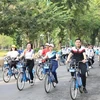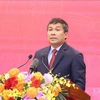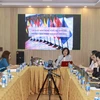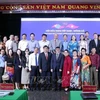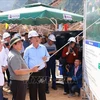Vietnam will tighten exit and entry of people under suspicion of being involved in transnational drug-related crime in the wake of a recent rise in cross-border transportation and trafficking of illegal narcotics.
This is part of a nationwide crackdown on the criminal activity from now to 2010, said the Drug-related Crime Investigation Police.
The drug investigation police unveiled that they are keeping a close watch on about 50 people, with women accounting for the majority, for their alleged connection to foreign-led drug trafficking rings.
According to Deputy Chief of the Drug-related Crime Investigation Police Tran Nhu Nhan, under the guise of tourists or businesspeople, a number of foreigners have recently entered Vietnam to set up transnational drug trafficking rings.
These foreigners have sought to seduce Vietnamese women between 20-45 years of age, who lead a profligate lifestyle or are uneducated, into the illegal trade. The women are coaxed into working as transporters, receiving 300-500 USD for each successful trip transporting drugs in or out of the country, Nhuan revealed.
He also revealed that between the end of 2008 and June 2009, anti-drug officers brought to light 30 transnational drug-related cases and arrested 60 people believed to be involved.
During the past three months, from June to the end of August this year, the officers, in collaboration with law enforcement at international airports and border gates, broke up five drug trafficking rings, arresting 26 foreigners and seizing up to 11.4 kg of heroin.
The most recent case was the arrest on October 28 of a Laotian national who trafficked seven cakes of heroine into the central province of Nghe An.
At a recent anti-drug conference, Deputy Minister of Public Security Le The Tiem warned that there has been a rise in drug trafficking into Vietnam overland through the northwest, the northeast, the northern central region, and the southwest, as well as by air.
As an example, police in southern Tay Ninh province, which shares a border with Cambodia, on October 22, broke up a drug transportation ring involving three foreign members. They confessed that they has spent time in Cambodian casinos bordering Tay Ninh province, engaging in the sale of illegal narcotics and using the locations as rendezvous points for drug traffickers, before entering Vietnam.
Investigation officer Tran Nhu Nhan related that drug smugglers have taken advantage of loose management by authorized agencies on granting visas and passports to foreigners to increase their illegal operations in the country.
He also blamed the use of out-of-date detection equipment at airports in reducing law enforcement officers’ ability to detect heroin being hidden in ever-more sophisticated ways in visitors’ luggage.
To deal with such crimes, localities have taken their own measures.
The central province of Nghe An has, for example, suggested the establishment of a liaison office in Laos’ Huaphane province to stop drugs being smuggled into Vietnam.
Meanwhile, Tay Ninh police has reinforced coordination with the Cambodian provinces of Svay Rieng and Kongpong Cham to control drug use and trafficking.
The two localities have also clamped down on “drug hotspots” at border communes./.
This is part of a nationwide crackdown on the criminal activity from now to 2010, said the Drug-related Crime Investigation Police.
The drug investigation police unveiled that they are keeping a close watch on about 50 people, with women accounting for the majority, for their alleged connection to foreign-led drug trafficking rings.
According to Deputy Chief of the Drug-related Crime Investigation Police Tran Nhu Nhan, under the guise of tourists or businesspeople, a number of foreigners have recently entered Vietnam to set up transnational drug trafficking rings.
These foreigners have sought to seduce Vietnamese women between 20-45 years of age, who lead a profligate lifestyle or are uneducated, into the illegal trade. The women are coaxed into working as transporters, receiving 300-500 USD for each successful trip transporting drugs in or out of the country, Nhuan revealed.
He also revealed that between the end of 2008 and June 2009, anti-drug officers brought to light 30 transnational drug-related cases and arrested 60 people believed to be involved.
During the past three months, from June to the end of August this year, the officers, in collaboration with law enforcement at international airports and border gates, broke up five drug trafficking rings, arresting 26 foreigners and seizing up to 11.4 kg of heroin.
The most recent case was the arrest on October 28 of a Laotian national who trafficked seven cakes of heroine into the central province of Nghe An.
At a recent anti-drug conference, Deputy Minister of Public Security Le The Tiem warned that there has been a rise in drug trafficking into Vietnam overland through the northwest, the northeast, the northern central region, and the southwest, as well as by air.
As an example, police in southern Tay Ninh province, which shares a border with Cambodia, on October 22, broke up a drug transportation ring involving three foreign members. They confessed that they has spent time in Cambodian casinos bordering Tay Ninh province, engaging in the sale of illegal narcotics and using the locations as rendezvous points for drug traffickers, before entering Vietnam.
Investigation officer Tran Nhu Nhan related that drug smugglers have taken advantage of loose management by authorized agencies on granting visas and passports to foreigners to increase their illegal operations in the country.
He also blamed the use of out-of-date detection equipment at airports in reducing law enforcement officers’ ability to detect heroin being hidden in ever-more sophisticated ways in visitors’ luggage.
To deal with such crimes, localities have taken their own measures.
The central province of Nghe An has, for example, suggested the establishment of a liaison office in Laos’ Huaphane province to stop drugs being smuggled into Vietnam.
Meanwhile, Tay Ninh police has reinforced coordination with the Cambodian provinces of Svay Rieng and Kongpong Cham to control drug use and trafficking.
The two localities have also clamped down on “drug hotspots” at border communes./.




